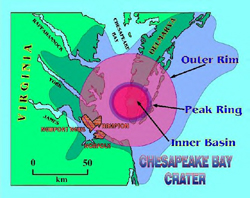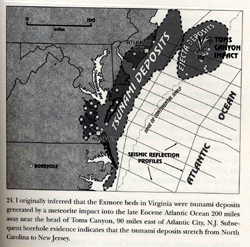DEEP IMPACT
Between 1980 and 1999, scientists zeroed in on the Chicxulub crater in Yucatan as the 200-mile-wide entry wound in the case of the dead dinosaurs. (There are, however, doubts). An asteroid or comet slammed into the earth 65 million years ago and so disrupted the climate that it wiped out 70 percent of the species then living.
Since then, we've looked to the skies for The Threat. "Dinosaur" is a metaphor for the laggard, stupid qualities in the human race. The Police sing a song and warn we're walking in their footsteps. Hollywood movies like "Deep Impact" show the human species going the way of the triceratops, dispatched by the same bullet. Often a tsunami figures in this. Given the proportion of ocean to land surface on the planet, after all, a meteorite has a better-than-70-percent chance of hitting water.
And now, while we're looking up for death from the skies, Mother Nature pulls the rug out from under us. Calamity comes from beneath our feet.
The East Coast of the U.S., where I live, doesn't seem to be in danger of that kind of earthquake-born tsunami. We're on the trailing edge of the continental plate, and the Atlantic is geologically a quiet place. But if you want a glimpse of what a tsunami might mean in this part of the world, there is a place to find it.

This map shows one of the largest craters ever identified on the Earth. The dark pink ring is the crater itself, the blue blob around it is the debris field of what was ejected out of it by the blast. It's not visible now; like Chicxulub it's buried under later layers of rock and sediment. But its story is told in a book called "Chesapeake Invader," by C. Wylie Poag, the geologists who pieced together the clues and found the crater.
One of the important first clues was the identification of the smaller "Tom's Canyon crater," which he found off the coast of New Jersey. Like the Chesapeake impact, it happened about 35 million years ago, and the two meteorites probably are related, perhaps parts of a larger body that fell apart before it struck the Earth. In imagining the effect of such an asteroid hit, Poag writes about the "super tsunami" it would spawn.
In theory, any large meteorite impact into the ocean would initiate a series of gigantic tsunami waves. The maximum estimated height of the waves at the impact site would equal the depth of the water there. The microfossil evidence indicated that the late Eocene water depth at impact was around 1,500-2,000 feet. This meant that the super tsunami would have started out being a quarter to half a mile high, but wave heights would gradually degrade as the tsunami moved away from the impact site. When the waves moved into shallow water near the shoreline, however, they would begin to feel bottom; this would slow down the wave fronts and cause their crests to rise again to forty times their open-ocean height. At the shoreline, then, the waves would have been hundreds, possibly even thousands, of feet high.
The waves would have hit the mid-Atlantic coast within minutes. "There the enormous hydraulic power of the churning waters would easily have stripped unconsolidated sedimentary beds from the floor of the continental shelf and from the coastal plains of Virginia, all the way to the Appalachian foothills. The powerful backwash of the waves would transport the scoured-out fragments back into the sea. Eventually, within a few hours or days, the seaward backrush would have piled most of the rock debris into a thick deposit" on the shallow seafloor.

This map, from Poag's book, shows the amount of debris piled up beneath the Atlantic coast from that tsunami backwash.
And that's just from the Tom's Canyon crater, not the much larger Chesapeake one. That bigger blast would have fried every living thing within 600 miles, though, so the tsunamis from it, however awful, would be something of an afterthought.
The climate was warmer then, the seas were higher and the East Coast shoreline was further inland. But the idea of a wave crashing and foaming inland as far as Washington, D.C., or Philadelphia is still an awesome vision.
Here's a good site to read more about the Chesapeake Bay meterorite.
Poag's book is not as good as it could have been. The writing is awkward and repetitive. He rightly focuses the narrative on the detective work and the unfolding of evidence that led him and others to find the Chesapeake crater. And he alludes to the scientific pecking order and turf jealousy that made him triple-check his results before he announced them. This part of the tale could have been given more depth, without much more text.
There's a fascinating, but unexplored, subtext to meteorite hunting, since it converges astronomy and geology, which are as different as the Elves and the Dwarves in Tolkien. The boys who sit on the hills gazing out at the heavens take one path into science, and it's different from the path taken by the boys who clamber into caves and come home muddy at dark.
Poag and his partners are the men and women in work boots digging for oil and fresh water to pump up out of the rocks. But here they find the fallen star that the astronomers dream about. Ad aspera per astra.
INDEX - AUTHOR
